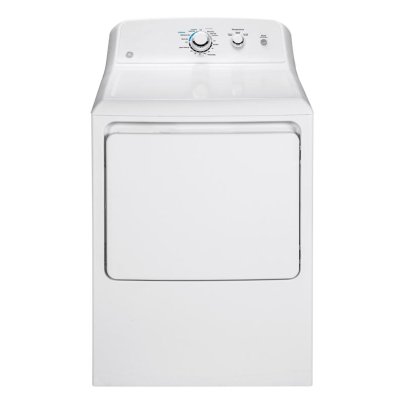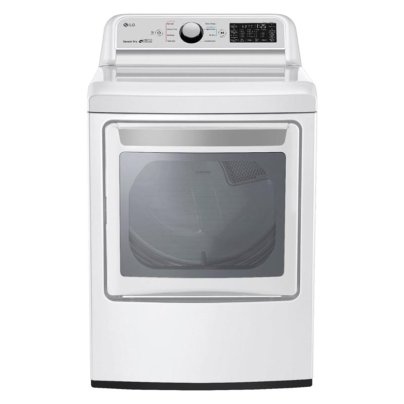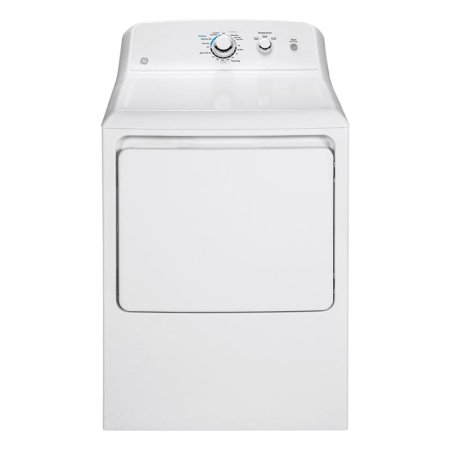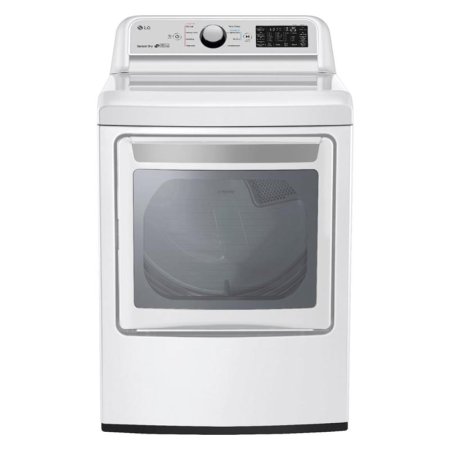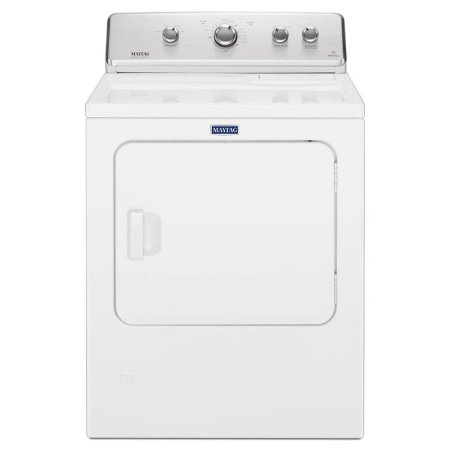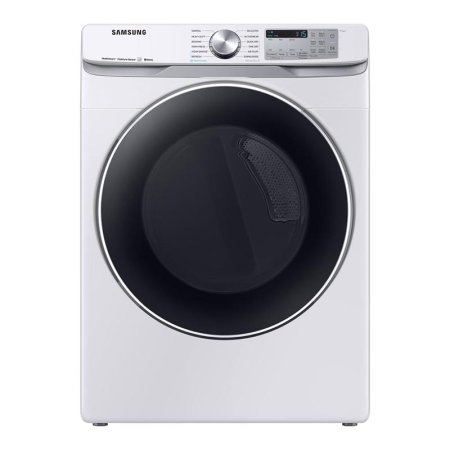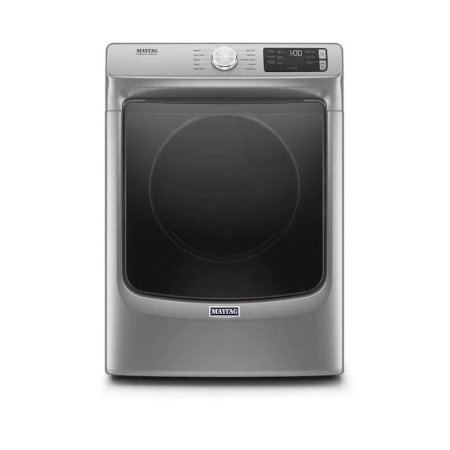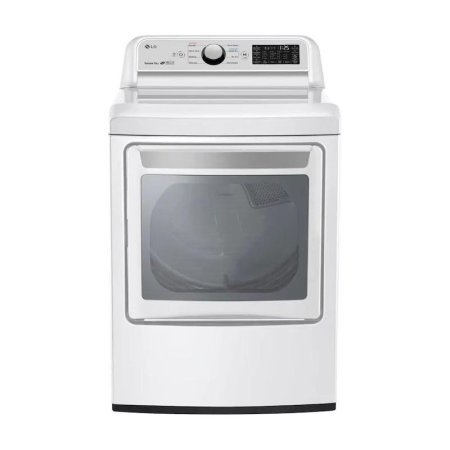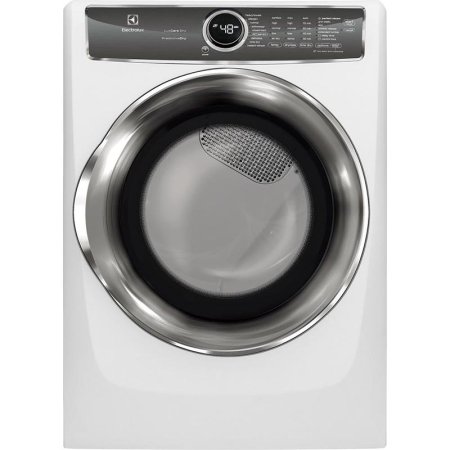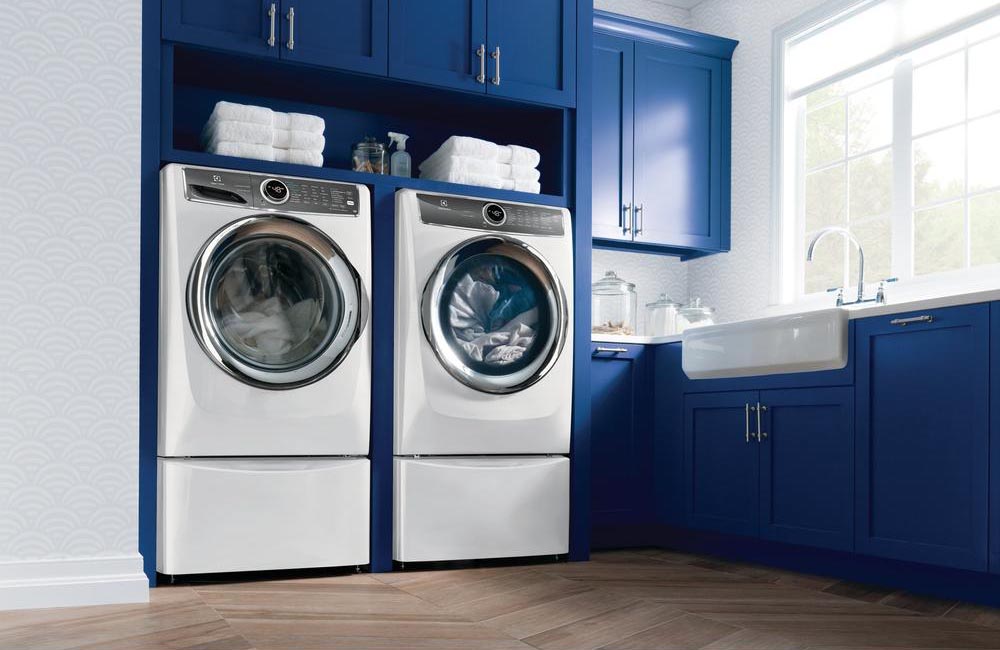
We may earn revenue from the products available on this page and participate in affiliate programs. Learn More ›
Purchasing a new dryer can be an overwhelming prospect. While all dryers serve the same purpose—drying your clothes using hot air—they vary in how well they accomplish that task. Some of the best dryers come with a dozen or more drying cycles and up to four different temperatures, allowing you to skillfully dry many different fabrics. Others include sensors that can determine the optimal time and temperature to dry your clothes without causing shrinkage or fading. Those with steam functions remove wrinkles and harmful germs from your clothes and linens. Newer ventless dryers offer high efficiency by recycling air, eliminating the need for a dryer vent, while technologically advanced smart dryers will send you alerts on your phone or tablet.
If you’re upgrading your laundry room, read on to learn about what considerations you should take into account while shopping for the best dryer.
- BEST OVERALL: Whirlpool Gas Vented Dryer with Wrinkle Shield Plus
- BEST BANG FOR THE BUCK: GE 3-Cycle Electric Dryer
- BEST ELECTRIC DRYER: LG 9-Cycle Electric Dryer
- BEST GAS DRYER: Maytag Gas Dryer with Wrinkle Control
- BEST STEAM DRYER: Samsung Electric Dryer with Steam Sanitize+
- BEST STACKABLE DRYER: Maytag Front Load Stackable Vented Electric Dryer
- BEST SMART DRYER: LG EasyLoad Smart Wi-Fi Enabled Electric Dryer
- BEST LARGE-CAPACITY: Electrolux 8.0 cu. ft. Electric Dryer with Steam
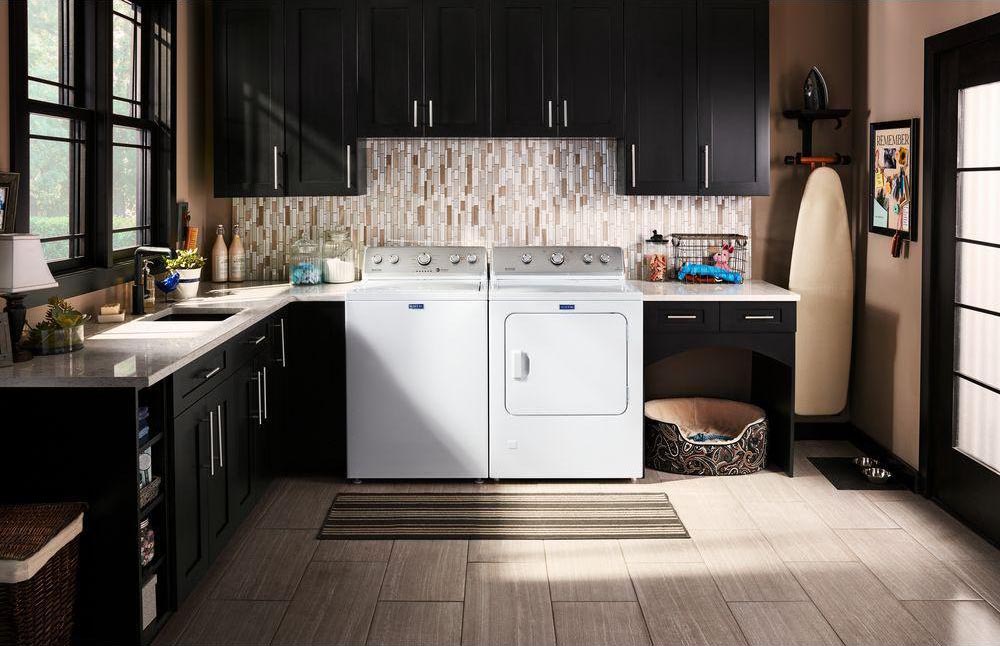
Types of Dryers
Dryers can be either vented or unvented, powered either by electricity or natural gas. Ventless dryers are more expensive up front but feature efficient designs that can save you money on your utility bill in the long run.
Gas Dryers
Gas dryers are a bit of a misnomer. All dryers use electricity to spin the drum that keeps your clothing moving during the drying cycle. The difference with gas dryers is that instead of using electricity to create the heat that dries your clothes, they generate hot air through propane or natural gas. These units tend to be a little more expensive; however, they work faster, making them more energy efficient. Depending on where you live, gas also tends to be cheaper than electricity. Keep in mind that you must have a gas line installed to use a gas dryer, which may add hundreds of dollars to your bill if you don’t already have one. Gas dryers also require a vent for carbon monoxide.
Electric Dryers
Electric dryers use a heating element to warm the air in the dryer. They are less efficient than gas dryers because they take longer to heat up and therefore take more time to dry your clothes. Electricity also tends to cost more than gas, which makes these units more expensive to run. Electric dryers require a 240-volt circuit, which most laundry rooms have.
Vented Dryers
Vented dryers work by pushing warm air into the dryer, where it runs through the tumbling clothes, causing the moisture in the clothes to evaporate. The moist air then travels through a large hose and out an outdoor vent. These vents must be cleared of lint periodically to prevent a fire hazard.
Condenser Dryers
Condenser dryers also pump warm air into the dryer; however, instead of discharging this air out of an exhaust vent, the air runs through cold water. The water cools the air, which causes the moisture to turn into water, which is then pumped out of the dryer to the same drainpipe the washer uses. Because these units recycle warm air, they are more efficient than standard dryers. They also operate at lower temperatures, making them easier on your clothes. This also means they take longer to dry clothes.
Heat Pump Condenser Dryers
Like a condenser dryer, a heat pump dryer recycles the warm air in the dryer, making it more efficient. The only difference is a heat pump condenser dryer cools the warm air using cold air as opposed to cold water.
What to Consider When Choosing the Best Dryer
Today’s dryers go beyond just drying your clothes with hot air. Many of these high-tech machines offer features that smooth wrinkles, sense when your clothes are dry, and even connect to smart devices.
Size and Capacity
A typical full-size dryer ranges in capacity from about 7 cubic feet to 8 cubic feet. Units can be as small as 3.5 cubic feet or as large as 9 cubic feet. A good rule of thumb for determining just how large your dryer should be is to use your washing machine’s capacity as a barometer. To capably dry a full load of laundry, a dryer should have about twice the capacity of its partner washer. Conversely, it doesn’t make sense to spend extra for a dryer with a capacity of 9 cubic feet if your washer can only handle 2.5 cubic feet.
Dry and Steam Settings
Dryers feature a variety of settings to optimize the drying process for your clothes. Air fluff uses no heat, allowing you to freshen up dry clothes with a dryer sheet. Permanent press is a medium heat setting that dries while preventing fading. A delicate or gentle cycle uses low heat for fabrics like silk and rayon, while regular cycles provide high heat for harder-to-dry household linens such as thick towels and comforters. Some higher-end dryers feature steam cycles, which use hot moist air to remove wrinkles from fabrics and kill germs and bacteria.
Control Panel
Dryers have control panels that are designed to be easy to use. Higher-end dryers feature digital control panels with easy-to-read displays. Many dryers feature a single large knob, which allows you to quickly set the dryer to one of its many cycles. Standard dryers feature control panels located at the rear of the unit, while stackable dryers have control panels on the front of the unit.
Energy Efficiency
Next to refrigerators, dryers are the biggest energy hogs when it comes to home appliances. According to the Environmental Protection Agency’s Energy Star rating system, a standard-size dryer will use nearly 1,000 kilowatts of energy per year on average. An Energy Star-certified dryer will use about 20 percent less energy than standard dryers. A ventless dryer can save up to 60 percent in energy usage.
NSF Certification
NSF International, an organization that sets sanitation standards, certifies dryers that effectively remove allergens, bacteria, and germs. Dryers that have earned NSF certification will remove 99.99 percent of microorganisms in clothing while preventing any transfer of contaminants from one load of laundry to another.
Smart Technology
Like many household appliances, some dryers feature smart technology that allows you to connect them to a smart device via a Wi-Fi connection. When used with the manufacturer’s app, these smart dryers will enable you to start, stop, and monitor the dryer via your phone or tablet. You can also program your dryer to alert you when it has completed a dryer cycle or if it malfunctions.
Additional Features
Dryers include a variety of features aimed at optimizing performance. End-of-cycle alarms let you know when the drying cycle is complete. Dryers with wrinkle shields will cycle the laundry off and on, keeping your clothes warm until you’re ready to empty it. Some even feature sensors that let you know when the lint filter needs changing or if debris is clogging the vent.
Our Top Picks
The dryers below reflect the considerations above and feature some of the best in each class.
Best Overall
Whirlpool Gas Dryer with Wrinkle Shield Plus
One of the biggest knocks on dryers is their tendency to overdry clothes, resulting in frustrating shrinkage and color fading. Whirlpool addresses that issue with its innovative AccuDry sensor technology, which automatically stops the dryer when the load is dry. It also lets you fine-tune the settings for jeans, silky lingerie, and more with an impressive 13 drying cycles and five temperature settings.
A wrinkle-shield setting intermittently tumbles the dryer’s contents when the cycle is over, while an end-of-cycle alarm lets you know when the cycle has ended. With 7 cubic feet of capacity, this dryer can handle bedspreads and other bulky items. A hamper-style door makes it easy to empty the dryer without dropping clean clothes on the laundry room floor.
Best Bang for the Buck
GE 3-Cycle Electric Dryer
This dryer from well-respected appliance giant GE offers some impressive features at an affordable price. While this dryer may not have the bells and whistles of higher-end models, it does feature the essentials, including an auto-dry setting that monitors the air temperature to optimize drying time.
Three heat options—regular, medium, and air fluff—allow you to set temperatures for different fabric types. Cycles include time dry, cottons, and casual. With 7.2 cubic feet of capacity, this dryer offers ample space for clothes. The dryer’s front door is reversible, allowing you to tailor it to coordinate with the washer. Simple rotary controls make setting this dryer quick and easy. This model is available in both gas and electric.
Best Electric Dryer
LG 9-Cycle Electric Dryer
With its numerous settings and advanced features, LG offers one of the most impressive electric dryers you can buy with this Energy Star-rated model. Topping this dryer’s long list of specs is LG’s ThinQ technology, which allows the user to turn it off and on or change the cycle from regular to delicates to permanent press from a smart device. Nine drying cycles offer enough versatility for washing different types of clothes, while five temperature settings let you dry materials ranging from silk to denim. With its large 7.3 cubic feet of capacity, this dryer can handle large quilts and comforters. Internal sensors track moisture levels, shutting down the dryer before overdrying occurs.
Other innovations include LG’s LoDecibel motor, which makes this dryer one of the quieter models you can buy, and a diagnostic feature that connects with an app on your smartphone to let you know what the issue is should the dryer malfunction.
Best Gas Dryer
Maytag Vented Dryer with Wrinkle Control
With its impressive features and large capacity, this dryer from Maytag is a worthy option for those with a gas dryer hookup in their laundry room. Topping its list of features is a set of built-in sensors that monitor moisture level and air temperature in the dryer to eliminate fabric-damaging overdrying.
With its 7 cubic foot capacity, this dryer offers ample space to handle the volume of a family of four or five. This dryer boasts 12 drying cycles, including settings for delicates, energy efficiency, and jeans. Four temperatures allow it to handle a variety of fabric types without doing damage. A wrinkle control setting keeps your clothes fresh until you can get to them, while a buzzer lets you know when the drying cycle is over.
Best Steam Dryer
Samsung Electric Dryer with Steam Sanitize+
Samsung’s Steam Sanitize+ setting uses the power of steam to remove wrinkles while eliminating 99 percent of germs and bacteria, 95 percent of pollen, and any dust mites that might be lurking in your clothes. It also includes various other features, such as a Sensor Dry system that automatically shuts off the dryer when the clothes are dry. A vent sensor lets you know when there is lint buildup in the dryer vent, while an indicator alerts you when the lint filter needs cleaning.
This Energy Star-rated dryer is enabled with Bixby, a smart assistant that allows you to control the dryer and receive alerts via a smart device. With 12 preset drying cycles, five temperature levels, and 10 drying options for different fabric types, this dryer provides you with an impressive range of controls.
Best Stackable Dryer
Maytag Front Load Stackable Vented Electric Dryer
A large capacity and innovative user features make this front load stackable dryer from Maytag an able partner for a good washer. It features a large 7.3 cubic foot capacity, making it capable of handling large loads and bulky items like bedspreads and sheets. Moisture sensing prevents the dryer from damaging your clothes by overdrying.
An Extra Power button extends the time and tumbling power of cycles, making it a good option for hard-to-dry items, such as bedding. A Quick Dry setting optimizes performance to dry small loads faster. Four temperature settings allow for versatile drying, while a wrinkle guard setting keeps your clothes fresh until you’re ready to unload them. Controls, complete with an easy-to-read digital display, are conveniently located in the front for easy access.
Best Smart Dryer
LG EasyLoad Smart Wi-Fi Enabled Electric Dryer
This dryer connects to ThinQ, the Wi-Fi technology that allows you to connect to LG’s smart appliances and electronics via your smartphone. When the dryer is connected to a Wi-Fi network, you can control the dryer via LG’s ThinQ app and get alerts letting you know when a cycle ends.
In addition to its smart features, LG also includes a host of innovations that make this dryer easy to use, including an EasyLoad dryer door that can open from the top down and from left to right. A sensor dry system prevents overdrying, while a FlowSense indicator lets you know when your dryer duct needs cleaning. A digital display makes accessing the dryer’s many cycles easy. This Energy Star-rated dryer boasts 7.3 cubic feet of space.
Best Large-Capacity
Electrolux 8.0 cu. Ft. Electric Dryer with Steam
A standard 7-cubic-foot dryer just won’t do for handling the volume of laundry produced by a large family. This large-capacity dryer rivals those you’d find at a laundromat with a whopping 8 cubic feet of capacity. This dryer offers features to make sure that those large loads get dried evenly without damaging your clothing. In just 15 minutes, the Fast Dry setting dries the clothes you need for work that day or an unexpected night out. With its internal drying sensors, this dryer can optimize the temperature and time just 90 seconds into a cycle for optimal performance.
Nine cycles allow for proper care of various fabric types, while a Perfect Steam setting eliminates wrinkles and annoying static cling. An end-of-cycle buzzer lets you know when the clothes are ready. This dryer won’t run up your electric bill despite its capacity, thanks to its Energy Star rating. This large-capacity model, which is 27 inches wide by 38 inches high by 31.5 inches deep, is also stackable.
FAQs About Dryers
If you’re still curious about how dryers operate, read on for answers to some of the most common questions about these appliances.
Q. How does a ventless dryer work?
A ventless dryer works by recycling the air that it uses. The dryer warms the air using a gas or electric heating element, which dries the clothes. The humid air then leaves the dryer compartment and travels into either a compressor or cold water that cools the air, removing the water vapor it collected from damp clothing. The condensed water exits using the same drainpipe as the washing machine. The air is then sent back to the heating element, where the cycle begins again.
Q. How hot does a dryer get?
The heat depends on the dryer model and its temperature setting. That said, most dryers have a maximum temperature of between 125 and 135 degrees.
Q. Do dryers kill germs?
If a dryer gets hot enough, it will kill more germs and bacteria. A dryer needs to reach a temperature of about 135 degrees to kill most bacteria and viruses. Cycle length also matters. A dryer that reaches 135 degrees should run for about an hour to thoroughly sanitize clothes.
Q. Is it OK to leave a dryer running overnight?
In addition to reaching high heat, a dryer also uses friction and motors. This creates a potential fire hazard, which means that you should never run a dryer while you’re away or at night while you’re sleeping.
Q. How long do dryers last?
A dryer should last about 10 to 13 years. You can extend your dryer’s lifespan by cleaning the lint trap regularly, keeping the vent lint-free, and periodically cleaning the drum interior.

